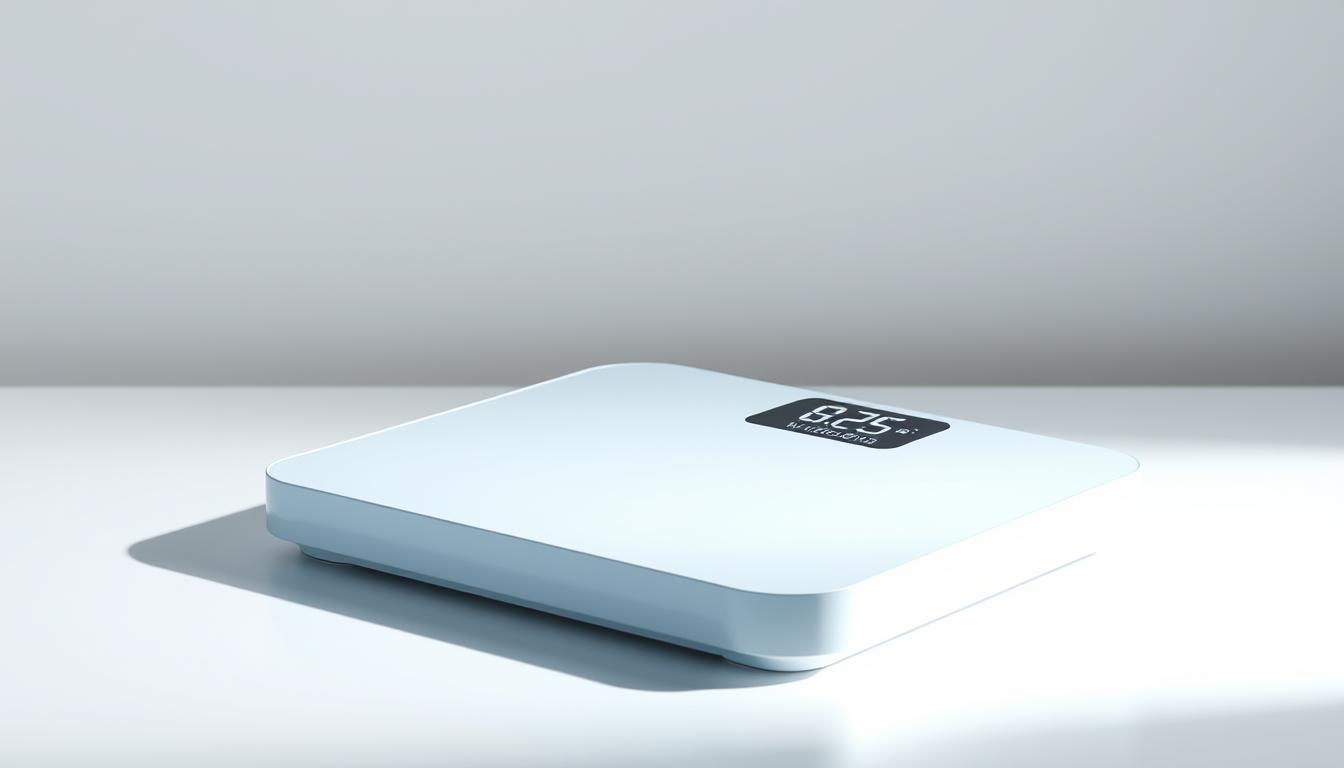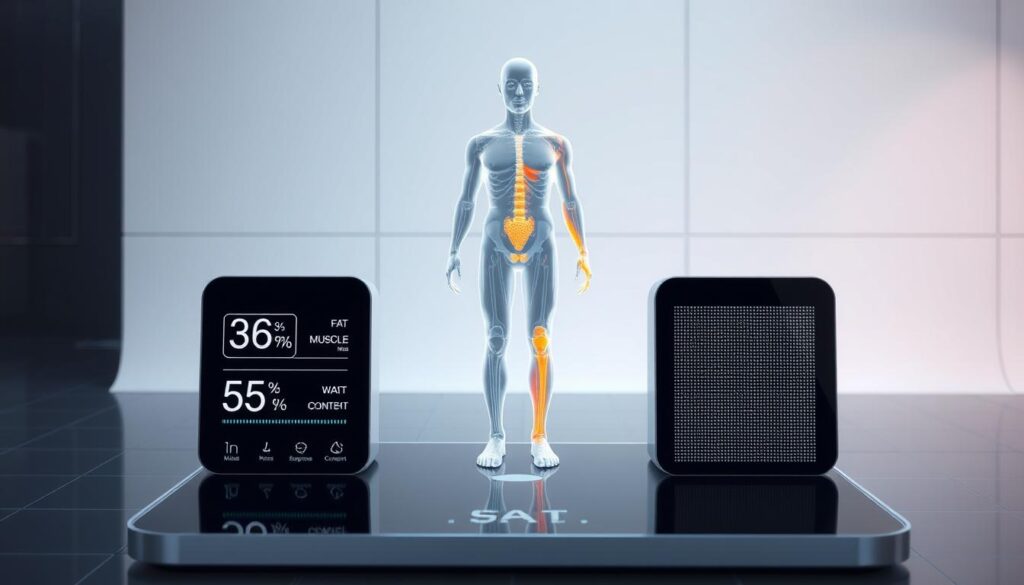“The greatest wealth is health.” – Virgil. This timeless quote emphasizes the importance of prioritizing our well-being, and in today’s world, technology has made it easier than ever to track our health metrics.
Tracking body composition is crucial for overall health assessment and fitness goals. Traditional scales only measure weight, but smart scales provide a comprehensive picture of our health by measuring body fat percentage, muscle mass, and other key health indicators.
By using a smart scale, we can gain valuable insights into our body composition and make informed decisions about our health and fitness routines. This information is especially important for those trying to lose weight or improve their overall health.
Key Takeaways
- Smart scales measure more than just weight; they track body fat percentage and other health metrics.
- Tracking body composition is essential for overall health and fitness goals.
- Smart scales provide valuable data to inform health and fitness decisions.
- Using a smart scale can help users monitor their progress and stay motivated.
- Smart scales offer a convenient and accessible way to track body composition at home.
Understanding Smart Scale Technology
Smart scales have revolutionized the way we track our health by providing a comprehensive overview of our body composition. These scales are not just limited to measuring weight; they offer a detailed analysis of various health metrics.
How Bioelectrical Impedance Analysis Works
Smart scales primarily use Bioelectrical Impedance Analysis (BIA) to measure body composition. BIA works by sending a small electrical current through the body and measuring the resistance it encounters. This resistance is then used to estimate body fat percentage, muscle mass, and other health metrics. The technology is based on the principle that different body tissues conduct electricity at varying rates.
Types of Measurements Smart Scales Provide
Modern smart scales can track a wide range of measurements beyond just weight and body fat percentage. These include muscle mass, bone density, water percentage, BMI (Body Mass Index), visceral fat, and metabolic rate. Having access to these multiple data points gives users a more complete picture of their body composition and overall health status.
| Measurement | Description | Importance |
|---|---|---|
| Body Fat Percentage | Percentage of body weight that is fat | Indicates risk of weight-related health issues |
| Muscle Mass | Weight of muscle in the body | Important for overall health and metabolism |
| BMI (Body Mass Index) | Ratio of weight to height | General indicator of health status |
By tracking these various measurements, users can gain a deeper understanding of their health and make informed decisions about their fitness goals.
Setting Up Your Smart Scale for Body Fat Measurement
The journey to understanding your body composition starts with setting up your smart scale for body fat measurement. To achieve accurate readings, it’s essential to follow a few critical steps.
Connecting Your Scale to Smartphone Apps
Connecting your smart scale to a smartphone app is a crucial step in tracking your body fat percentage and other health metrics. Most smart scales come with their own app, which you can download from the App Store or Google Play Store. Once installed, follow the in-app instructions to pair your scale via Bluetooth or Wi-Fi. This connection allows you to track your progress over time and receive insights into your health data.
Creating Your User Profile
After connecting your scale to the app, you’ll need to create a user profile. This typically involves entering personal details such as age, height, weight, and gender. Some scales may also ask for activity level or other health metrics. This information helps the scale provide more accurate body fat measurements and tailored health recommendations.
Positioning Your Scale Correctly
When using a body composition scale, it’s vital to place it on a hard, flat surface. Carpeting or uneven flooring can affect the accuracy of the measurements. Ensure the scale is level and stable before stepping on it. Some scales have adjustable feet to help with leveling on slightly uneven surfaces.
To further illustrate the importance of correct scale placement, consider the following factors and their impact on measurement accuracy:
| Factor | Impact on Measurement Accuracy | Recommendation |
|---|---|---|
| Surface Type | Hard surfaces provide more accurate readings than carpeted or uneven floors. | Use on hard, flat surfaces. |
| Scale Leveling | Ensures stability and accuracy. | Check that the scale is level; use adjustable feet if necessary. |
| Environmental Conditions | Temperature and humidity can affect scale performance. | Place the scale in a stable environment. |
By following these steps and considerations, you can ensure that your smart scale provides accurate body fat measurements, helping you track your health and fitness goals more effectively.
How to Use a Smart Scale for Body Fat Effectively
Effective use of a smart scale for body fat measurement involves more than just stepping on it; it requires a strategic approach. To maximize the benefits of your smart scale, you need to consider several factors that influence the accuracy of your body fat measurements.
Best Time of Day for Measurements
The time of day you take your measurements can significantly impact your body fat readings. It’s recommended to take measurements at the same time every day to ensure consistency.Morning is often considered the best timeas it allows for a more controlled environment, having just woken up and before eating or drinking anything. This helps in minimizing variables that could affect your body fat percentage.
Proper Stance and Positioning
Proper stance and positioning on the scale are crucial for accurate readings. Stand on the scale with bare feet, ensuring your feet are in contact with the electrodes. Maintain astraight posture and distribute your weight evenlyon both feet. This ensures that the bioelectrical impedance analysis (BIA) can accurately measure your body fat.
Consistency in Measurement Conditions
Consistency is key when tracking body fat measurements. Factors such as hydration levels, recent meals, and exercise can affect your readings. To get reliable trends, it’s essential to standardize your measurement conditions. For instance, Dennis suggests,
“Don’t worry over a particular reading on your scale at home… Instead, use it as a way to track body composition trends over time.”
This means trying to measure yourself under the same conditions each time. You can refer tothis guidefor more detailed tips on using a smart body fat scale effectively.
To achieve consistency, consider the following checklist:
| Condition | Standardization Tip |
|---|---|
| Time of Day | Measure at the same time every day |
| Hydration Level | Avoid measuring after intense hydration or dehydration |
| Recent Meals | Measure on an empty stomach or after a consistent period of fasting |
| Exercise | Avoid measuring immediately after exercise |
By following these guidelines and maintaining a consistent approach, you can ensure that your smart scale provides accurate and reliable body fat measurements over time.
Interpreting Your Body Fat Results
Once you’ve obtained your body fat measurements, the next crucial step is understanding what the numbers mean. Your smart scale provides a wealth of information, but it’s essential to interpret this data correctly to make informed decisions about your health and fitness.
Understanding Healthy Body Fat Percentage Ranges
Body fat percentage is a more nuanced measure than weight alone, as it differentiates between lean mass and fat mass. For adults, healthy body fat ranges vary by age, gender, and activity level. Generally, for men, a body fat percentage of 8-19% is considered athletic, while 20-25% is average. For women, 16-23% is athletic, and 24-31% is average. Understanding these ranges helps you assess your health status and set realistic goals.
Tracking Changes Over Time
Tracking your body fat percentage over time is more informative than a single measurement. By monitoring changes, you can assess the effectiveness of your diet and exercise regimen. Consistency is key; measure yourself under the same conditions each time to ensure accurate comparisons. This longitudinal data helps you identify trends and make necessary adjustments to your health management strategy.
Integrating Results with Fitness Apps
To maximize the value of your body fat measurements, integrate them with fitness apps and health tracking platforms. Connecting your smart scale to comprehensive health ecosystems like Apple Health, Google Fit, Fitbit, or Garmin Connect creates a centralized hub for your health data. This integration allows you to see correlations between your body composition, activity levels, nutrition, and sleep metrics, providing a holistic view of your health. For instance, you can check your app, which should automatically update with your latest stats, including weight, muscle, and fat percentages.
By leveraging app features like goal setting, progress visualization, and achievement recognition, you can stay motivated on your fitness journey. Moreover, some apps offer additional insights, trend analysis, and personalized recommendations based on your body composition data. This integrated approach enhances your ability to manage your health effectively.
Limitations and Alternatives for Body Composition Tracking
Body fat scales are just one tool among many for measuring body composition; understanding their limitations is key to effective body fat management. While they offer convenience, their accuracy can be affected by various factors including hydration status, recent exercise, and individual body variations.
It’s crucial to recognize that smart scales provide estimates rather than clinical-grade measurements. For more precise assessments, alternative methods such as DEXA scans, hydrostatic weighing, air displacement plethysmography (Bod Pod), skinfold calipers, and 3D body scanning are available. Each method has its own trade-offs in terms of accuracy, accessibility, cost, and convenience.
For certain individuals, such as athletes or those with specific health concerns, more advanced measurement techniques may be necessary. Moreover, different methods can complement each other, with home scales used for regular tracking and professional methods for periodic calibration. Special consideration should be given to populations for whom bioelectrical impedance may be less accurate, such as pregnant women or children.
Ultimately, the choice of body composition tracking method depends on individual goals, budget, and access to facilities. By understanding the strengths and limitations of each method, individuals can make informed decisions about their health and fitness journey.


